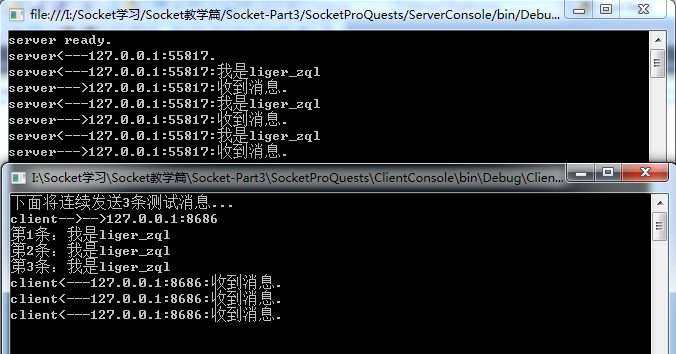Socket编程 (异步通讯,解决Tcp粘包) - Part3
Socket编程 (异步通讯,解决Tcp粘包)
从上一章的通讯中,我们发现如果使用Tcp连续发送消息会出现消息一起发送过来的情况,这样给我们编程造成一定的问题,给我们的信息解析造成一定的问题。那么这篇文章就将针对以上问题给出解决方案......
问题一般会出现的情况如下,假设我们连续发送两条两天记录("我是liger_zql"):
模拟发送示例:
#region 测试消息发送,并匹配协议 TcpClient client = new TcpClient(); client.AsynConnect(); Console.WriteLine("下面将连续发送2条测试消息..."); Console.ReadKey(); MessageProtocol msgPro; for (int i = 0; i < 2; i++) { msgPro = new MessageProtocol("我是liger_zql"); Console.WriteLine("第{0}条:{1}", i + 1, msgPro.MessageInfo.Content); client.AsynSend(msgPro); } #endregion
接收端接受两条信息会出现如下三种情况:
1.(1)我是liger_zql(2)我是liger_zql
2.(1)我是liger_zql我是(2)liger_zql
3.(1)我是liger_zql我是liger_zql
通过以上三种情况,显然2、3都不是我们想要的结果。那么如何处理这中情况呢?
解决方案:通过自定义协议...
我们可以以将信息以xml的格式发送出去,列入<protocol>content</protocol>通过正则匹配信息是否完整,如果不完整,我们可以先将本次接受信息缓存接受下一次信息,再次匹配得到相应的结果。
将信息对象转换成一定格式的xml字符串:
/// <summary> /// 文本信息 /// </summary> public class MessageInfo { public string Content { get; set; }//信息内容 public MessageInfo(string content) { this.Content = content; } public override string ToString() { return String.Format("<message Content=\"{0}\" />", this.Content); } } /// <summary> /// 文件信息 /// </summary> public class RequestFile { public string Address { get; set; }//发送端Ip public int Port { get; set; }//端口号 public RequestMode Mode { get; set; }//请求类 public FileObject FileObject { get; set; }//文件详细参数 public RequestFile() { } public RequestFile(RequestMode mode, FileObject fileobject) { this.Mode = mode; this.FileObject = fileobject; } public RequestFile(string address, int port, RequestMode mode, FileObject fileobject) { this.Address = address; this.Port = port; this.Mode = mode; this.FileObject = fileobject; } public RequestFile(string address, int port, RequestMode mode, string filename, long filelength, int packetsize, long packetcount) { this.Address = address; this.Port = port; this.Mode = mode; this.FileObject = new FileObject(filename, filelength, packetsize, packetcount); } public override string ToString() { StringBuilder sbString = new StringBuilder(); sbString.Append("<message "); sbString.Append(String.Format("Address=\"{0}\" ", Address)); sbString.Append(String.Format("Port=\"{0}\" ", Port)); sbString.Append(String.Format("Mode=\"{0}\" ", Mode)); sbString.Append(String.Format("FileName=\"{0}\" ", FileObject.FileName)); sbString.Append(String.Format("FileLength=\"{0}\" ", FileObject.FileLength)); sbString.Append(String.Format("PacketSize=\"{0}\" ", FileObject.PacketSize)); sbString.Append(String.Format("PacketCount=\"{0}\" ", FileObject.PacketCount)); sbString.Append("/>"); return sbString.ToString(); } } /// <summary> /// 订立信息协议 /// </summary> public class MessageProtocol { public MessageType MessageType { get; set; } public MessageInfo MessageInfo { get; set; } public RequestFile RequestFile { get; set; } public MessageProtocol() { } public MessageProtocol(string msg) { MessageType = MessageType.text; MessageInfo = new MessageInfo(msg); } public MessageProtocol(RequestMode mode, FileObject fileobject) { MessageType = MessageType.file; RequestFile = new RequestFile(mode, fileobject); } public MessageProtocol(string address, int port, RequestMode mode, FileObject fileobject) { MessageType = MessageType.file; RequestFile = new RequestFile(address, port, mode, fileobject); } public override string ToString() { StringBuilder sbString = new StringBuilder(); sbString.Append(String.Format("<protocol Type=\"{0}\">", MessageType)); if (MessageType == MessageType.text) { sbString.Append(MessageInfo.ToString()); } else { sbString.Append(RequestFile.ToString()); } sbString.Append("</protocol>"); return sbString.ToString(); } public byte[] ToBytes() { return Encoding.UTF8.GetBytes(this.ToString()); } }
对接收的信息通过正则进行匹配处理:
//临时缓存 public string temp = string.Empty; //匹配协议获取信息 public List<MessageProtocol> HandlerString(string msg) { List<MessageProtocol> msgProList = new List<MessageProtocol>(); if (!String.IsNullOrEmpty(temp)) { msg = temp + msg; } string pattern = "(^<protocol Type=.*?>.*?</protocol>)"; if (Regex.IsMatch(msg, pattern)) { //匹配协议内容 string match = Regex.Match(msg, pattern).Groups[0].Value; //将匹配的内容添加到集合 msgProList.Add(HandlerObject(match)); temp = string.Empty; //截取未匹配字符串,进行下一次匹配 msg = msg.Substring(match.Length); if (!String.IsNullOrEmpty(msg)) { msgProList.AddRange(HandlerString(msg)); } } else { temp = msg; } return msgProList; }
然后将该定义的协议换换成信息对象,通过对象获取自己想要的信息。
//将已转成协议信息转成对象信息 public MessageProtocol HandlerObject(string protocol) { XmlDocument xmldoc = new XmlDocument(); xmldoc.LoadXml(protocol); XmlNode root = xmldoc.DocumentElement; XmlNode msgnode = root.SelectSingleNode("message"); MessageProtocol msgPro = new MessageProtocol(); if (root.Attributes["Type"].Value == MessageType.text.ToString()) { msgPro.MessageType = MessageType.text; msgPro.MessageInfo = new MessageInfo(msgnode.Attributes["Content"].Value); } else { msgPro.MessageType = MessageType.file; RequestMode mode = (RequestMode)Enum.Parse(typeof(RequestMode), msgnode.Attributes["Mode"].Value); FileObject fileobject = new FileObject(); fileobject.FileName = msgnode.Attributes["FileName"].Value; fileobject.FileLength = Convert.ToInt64(msgnode.Attributes["FileLength"].Value); fileobject.PacketSize = Convert.ToInt32(msgnode.Attributes["PacketSize"].Value); fileobject.PacketCount = Convert.ToInt64(msgnode.Attributes["PacketCount"].Value); msgPro.RequestFile = new RequestFile( msgnode.Attributes["Address"].Value, Convert.ToInt32(msgnode.Attributes["Port"].Value), mode, fileobject); } return msgPro; }
最后运行结果如下:

好了Tcp粘包的问题我们解决了。下一章我们将解决Udp丢包的个人解决方案!
附上源码:SocketProQuests.zip
作者:曾庆雷
出处:http://www.cnblogs.com/zengqinglei
本页版权归作者和博客园所有,欢迎转载,但未经作者同意必须保留此段声明, 且在文章页面明显位置给出原文链接,否则保留追究法律责任的权利

